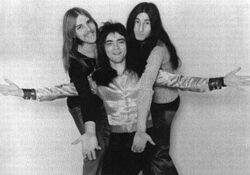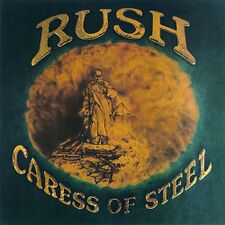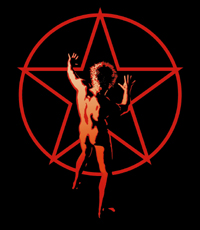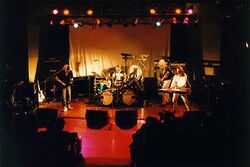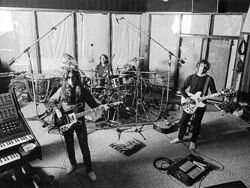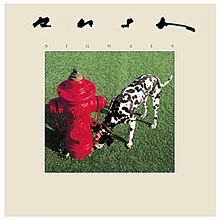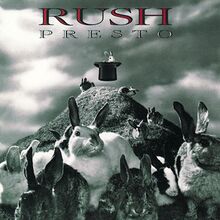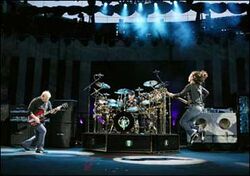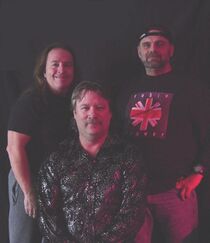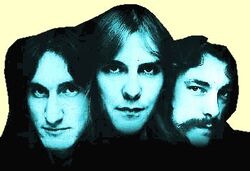Rush
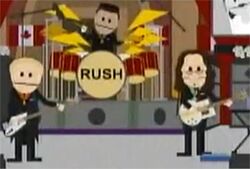
“Rush is like an orgasm for your ears...”
Rush was a progressive rock band from the wayward land of Canada. The power trio consisted of high-pitched wailing vocalist/bassist/keyboardist/violinist/sitarist/banjoist/samisen player/Minimoogist/Oberheim Polyphonist/Moog Taurus bass pedalist Geddy Lee, 6- and 12-string distorted wall-of-sound guitarist/wizard Alex Lifeson, and 4/17 jazz time 154-piece drummer/triangle player/percussionist/hat enthusiast/glockenspiel player/bell tree player/cowbellist/crotales/gong/orchestra bells/temple blocks/timpani/tubular bells/vibraslap/wind chimes/woodpecker noise-maker/part-time libertarian Neil Peart. Geddy and Alex are cool dudes; even Neil was pretty cool, despite also being kind of introverted. Rush is known for their complex sometimes-prog sometimes-pop musicianship, and whimsical adolescent lyrics drawing on fantasy geek themes such as hobbits, elves, slaying dragons, and defeating overlord super-sharks who wear silky capes and eat people. Despite (or perhaps because of) its cheesiness, their music can't help but make you smirk smugly and feel simultaneously dorky-yet-cooooool every time it rushes through your ears.
Rush accomplished a lot in their 21^12 years on this Earth. They traveled time and met Tom Sawyer, battled and defeated the Priests of the Temples of Syrinx, defended By-Tor from raving snow dogs, spent a day in the limelight, made big money after becoming working men, single-handedly invented progressive metal, and done so many other things that only hardcore Rush fans care about. Their musical style is considered the prime inbred cousin between Iron Maiden and Yes, and they are, along with Dream Theater, one of the most famous examples of non-British musicians who make progressive rock. Rush called it a day in 2018, and Geddy and Alex reaffirmed the band's dissolution after Peart's death in 2020.
History[edit]
1968–73: Formation[edit]
Rush's original lineup, consisting of lead vocalist/bassist/frontman Jeff Jones, drummer John Rutsey, and Guitar Jesus Alex Lifeson, was formed in 1968 by school friends in Willowdale, a neighbourhood of the vast canned foods aisle that is Toronto, Canada. Jones later left the band to join his fellow Christian rockers Ocean and was replaced by Gary Lee, renown for his rather gargantuan nose and Ozzy Osbourne-esque glasses. Due to a fatal Canadian mishap, the band's accents made it come out as "Geddy" when they said his name, and this mondegreen stuck. The band went through several configurations, at one point temporarily changing their name to "Hadrian" and replacing Geddy and Alex with bassist/singer/hoser Bob McKenzie and guitarist/bartender Doug McKenzie, before looping back to the name Rush and the Lee/Lifeson/Rutsey lineup.
Before they released any album, Rush frustrated themselves playing at venues where barflies threw beer at them, and they were much different from what we know today, being something of a Led Zeppelin tribute band. Their first single, released on their self-founded Moon Records label, was a cover of the Buddy Holly song "Not Fade Away" that would ironically fade away from the public eye very quickly. Unbeknownst to all except nerds and stakers of Rush, there are rumours of other Rush songs written pre-1974; the names and subjects of these songs, such as "Losing Again" and "Child Reborn", are even more shrouded in darkness than the very existence of the songs.
1974–76: Singin' the blues[edit]
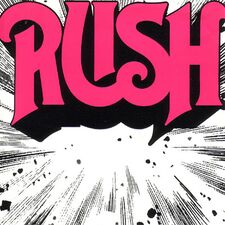
Together with engineer Terry "Broonsie" Brown, Rush recorded their self-titled, self-produced debut album Rush (1974), originally titled We Refuse to Have a Self-Titled Album. Like many other bands such as the Beastie Boys, Rush did not know what kind of sound they wanted when they first stated; the album had its merits, but songs like "Finding My Way" (fittingly-titled), "What You're Doing" (again a title befitting the band's early development), and "In the Mood" (with the Glenn Miller Orchestra) sounded more like faux-Zeppelin blues/hard rock than the prog we would know and love them for in the future, although the track "Before and After" hinted at prog aspirations to come. The band found moderate success with the single "Working Man", a blue-collar anthem Geddy wrote about his grandpa that was too senile to realize he could retire, and it sold enough for them to produce a second album. After the first album, Rutsey left Rush because his newly-acquired diabetes made him drum too slowly to keep up with the rest of the band; apparently, Lifeson forgot to close their apartment refrigerator properly, leading the drummer to ravage the leftover cake.
This led Geddy and Alex to look for a new drummer, which they found in the walking, talking, and occasionally hallucinating drum machine, Prof. Neil Peart. Peart also became the group's lyricist, because Geddy would only write about things he read in fairytales. Later, Mercury Records offered Rush a contract after watching them try out for Canada's Got Talent, which they enthusiastically accepted; Terry Brown was also promoted to producer. Pitying the current state of the band, The Professor decided to give it a shake-up in every sense of the word. His hiring led to instantly-improved drumming and more science fiction- and libertarian-oriented songs on their 1975 second album Fly by Night, such as "Anthem", a Randthem ode to Peart's idol Ayn Rand, and their first epic "By-Tor and the Snowdog". However, the band had not quite shed their faux-Zepp mold yet, as shown by other songs like the title track and "Best I Can". The album's title was derived from what the Professor told Geddy after he lost his ticket to a daytime flight to their next concert. The album is also known for its cover artwork, depicting the mighty Canadian owl. Many people learned about Fly by Night not from their Rush fandom, but rather from this book by the Onion named Our Dumb World. There's an X in the corner of the Canada section in the Northwest Territories that says "Crowd from 1975 'Fly by Night' tour still waiting for Neil Peart to finish drum solo." Of course it was referencing Rush, because let's face it: the only thing more Canadian than Rush is Robin Sparkles, eh?
“That's not bread...lemony cake!
There's no end to what they'll take.
Flaunt the fruits of noble birth,
Wash the salt into the earth.
But they're marching to Bastille Day.
La guillotine will claim her bloody prize!”
“Let them eat cake, she said, just like Marie Antoinette.”
The beginning of Jimmy Carter's presidential campaign resulted in the somewhat lacklustre 1975 effort, Caress of Steel (And Other Various Metals). This questionable title was developed when Terry Brown brought Geddy to the zoo, and they witnessed how seals were trapped in claustrophobic steel-encased pools, away from their natural habitats and constantly feeling the caress of steel when bumping into the walls; this shocked Geddy, as he himself had seal relatives in Winnipeg. The resulting album is seen as the band's first true meddling into long-ass music, with not one but two epics, "The Necromancer (I. Into the Graveyard; II. Under the Ground; III. Retina Urn of the Prince)" and "The Fountainhead of Lamneth", both of which occupy the majority of the record's grooves. The other songs on the album, however, were less progressive: "Bastille Day", a French Revolution version of Independence Day (Bienvenue sur Terre!); "I Think I'm Going Bald", a Kim Mitchell diss track; and "Lakeside Park", a college nostalgia song. The album received mixed reviews, indicating Rush was still getting their legs through the door and hadn't yet mastered the art of "Let's make our songs really really long." While Caress of Steel wasn't a favourite of many, listeners couldn't argue it didn't have one of the raddest album covers they had ever seen (don't believe me, look to your left). Robert Christgau gave the album a "dud" rating, saying "This album is so full of evil that it would make even KISS cry from sadness. Caress proves that, if anything, awful cockrock will take over the world and outlaw good music, but perhaps in the future, there will be a lone hero to restore the musical order." Rush apparently took this review in stride, seeing as they used it as the concept for their next album.
After the disappointing sales of Caress of Steel, the meandering cokeheads at Mercury pushed for Rush to create something, in their words, "...ahhh liTtlE morrreee acceSsibleeeee." Being the rebels that they were, the band gave Mercury the proverbial middle finger and wrote their most sprawling epic yet, 1976's 2112. The fan favourite album proved to be one of their most memorable and successful, and showed Rush finally sticking the landing. It was most notable for its titular 20-minute suite, about a boy in the dystopian future of 2112 where music is outlawed by the oppressive Priests of the Temple of Syrinx and their Solar Federation. The boy discovers a stray guitar and is banished from society, but returns to save the day from the tyrannical Priests; some stuff regarding Ayn Rand is also present. Despite being considered a concept album, only half of the album actually explores a concept; the second side consists of standalone generic blues songs like "A Train Passage to Bangkok", which is said to have been about drugs, and "Tears", which is allegedly about Curt Smith. That year, the band also released the live album All the World's a Stage (We Are Merely Players, Performers, and Portrayers); this album began the tradition of the band releasing four studio albums followed by a live album to demarcate each of their eras.
1977–81: Progressive bloat[edit]
“God DAMN what a Rush!”
Invigorated by their recent efforts with the highly-acclaimed and successful 2112, Rush followed up and delivered 1977's A Farewell to Kings, Queens, and Other Dignitaries. The album takes a nostalgic look at the Medieval days, where you were greeted not by a psychotic, wannabe President but rather the warm, glowing image of monarchs laughing at your peasant tuchus. The album also included the strikingly depressing "Closer to the Heart", which details how dodgy heart surgery used to be in Medieval times and how sometimes blacksmiths performed it on artists, thus getting germs on their organs and causing infections. The last song, the epic "Cygnus X-1: Part I", is the tale of an idiot who flew into a black hole, in fact part of a larger tale divided into two parts, but with the second part coming on the next release, much like a king and his queen. This album saw the band pushing and expanding the prog envelope even further than ever before to achieve a broader, progressive palette of sound, as Lifeson began experimenting with guitar distortion, Lee started wearing fancy robes and playing the Minimoog, and Peart's drumsticks grew several inches in size, producing an even bigger drum sound.
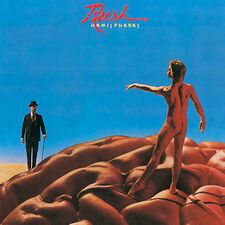
After the success of Kings, the band released their next album, Hemispheres (1978). It contained the conclusion to the Cygnus story "Cygnus X-2: Cygnus X-1 Part II, Cygnic Blackholgaloo", where the idiot escapes the black hole through spaceships and Greek mythology, another Ayn Rand tribute "The Trees", about economic and class inequality between the Maples and the Oaks, and the appropriately-subtitled instrumental exercise in self-indulgence "La Villa Strangiato (An Exercise in Self-Indulgence)", featuring an excerpt from that factory-type song you hear in every cartoon. After noticing how poorly other prog bands were responding to punk at the time with cheesy albums like Yes's Tormato, ELP's Love Beach, and Gentle Giant's Giant for a Day, Rush wisely decided to move away from their proggy roots after Hemispheres.
“No need to Rush.”
1980's Permanent Waves was originally intended as a King Arthur concept album à la Rick Wakeman, but Peart got bored with the idea and scrapped it. This album saw the band shifting their musical style dramatically via the general retirement of prog epics and the introduction of shorter song lengths, more pop-oriented rock, Geddy beginning to yodel less and singing in a lower register, Peart starting to write about more down-to-earth Ayn Randisms instead of Medieval/sci-fi Ayn Randisms, and whiteboy faux reggae. This new style was best exemplified on the hit singles "The Spirit of Radio" and "Freewill"; despite this, Rush still tossed their retro fans a bone with the faux-prog epics "Jacob's Ladder" and "Natural Science".
Rush's popularity reached its pinnacle with the release of Moving Pictures in 1981. The lead single and first track, "Tom Sawyer", explored the struggles of today's Tom Sawyer, the warrior who had a mean mean pride, while the followup single, "Limelight", dealt with how strangers are not long-awaited friends and kids should stay away from them. The album also contained the famous instrumental "YYZ", based on the morse code for the Toronto Pearson International Airport, but nobody really cared about it except when they saw Rush play it live, where Neil would perform 20-minute drum solos in the middle of the song. Pics was Rush's last album to feature a bloated prog epic, the eleven-minute Manhattan vs. London battle "The Camera Eye". Conversely, the closing track "Vital Signs", where the band desperately tries to morph into The Police, also contained their heaviest usage of fake reggae yet, hinting that Rush's musical picture was moving once more. The album reached #2112 on the Billboard Hot 2113 chart and was certified quadruple-duple-rectified platinum by the RIAA. This was the height of Rush's overall popularity and song quality, perfectly blending their prog and pop sides. That same year saw the release of the live album Exit...Stage Left, which shut the trapdoor on this Rush era.
1982–89: '80s synths and mullets[edit]
“God, imagine if we had to play like that now, or I had to yodel like that now? What a pain in the ass.”
While Geddy's mirror-shattering voice and thick basslines had been featured since the band's first album, 1982's Signals was when he started greatly utilizing another instrument: synthesizers. Keyboards were suddenly shifted from the cunnilingus rear-ends to the violent frontlines of every song. The album incorporated heavy use of flange, washed-over guitar feedback, analog distortion, '80s synths, and more pronounced whiteboi reggae; these extremities produced an intense New Wave euphoria that was just great to some fans, but felt like a sellout to others. Although Rush consciously moved in this direction as to not repeat themselves, creative differences between them and longtime producer Terry Brown began to emerge. The band felt dissatisfied with Brown's fuzzy sound mix of Signals, while Brown was becoming more uncomfortable with the synthesizers that were gnawing at his legs, and ultimately, the two parties parted ways in 1983. The hit singles from Signals were "Subdivisions", the lead-off track about '80s teen angst and invisible social lines, and "Countdown", the closing track which featured voice samples from the launch of Space Shuttle Columbia (little did the band know Columbia would suffer from Challenger syndrome in 2003).
“It's tough to be so cool.”
Rush's next album, Grace Under Pressure (1984), continued the direction of Signals, while incorporating more songs about dark and depressing themes including the Cold War, the Holocaust, and eternal nuclear winter. Peter Gabriel producer Steve Lillywhite Lillith was enlisted to produce Grace, but blew the band off at the last minute, forcing them to hire some other chap instead, that chap being Peter "Hentor the Barbarian" Henderson of Supertramp fame. Musically, although Geddy's synths still overpowered everything else, Lifeson was allowed to rock out more than on Signals, resulting in more radical guitar solos and tubular power chords than last time.

With new producer Peter Collins, Rush released 1985's Power-Chord Windows and 1987's Hold Your Cold Fire. These two albums put even less emphasis on Lifeson's guitar and more on cavernous electronic drums and meditative synths, making them smash hits with the the MTV crowd, but further steering away the TruFans™. A 1989 live album, A Show of Hams (referring to the band members' lively personalities), was released featuring songs from the Windows and Fire tours, with cover art depicting Rush as though they were in a painting from a hipster coffeeshop. This album was the last to showcase the band's one-finger-driven synth-based sound and their last on Mercury Records, closing the book on yet another era of Rush.
1989–2001: Return to guitar roots[edit]
Mercury Records then dropped Rush from their label, so they found refuge in Atlantic Records, home of fellow progheads Genesis and Yes. The band soon decided to ditch the synths and return to a more straightforward, stripped-down, guitar-driven sound. With this new sound, they spawned Presto (1989), an album with cute little wascally wabbits on the front. Presto was part of Rush's Third Empire (1989–2001), and had many new Imperial laws in their music, what with "Don't play synthesizers nearly as much" and "Show me, don't tell me." King Peter Collins II was overthrown by Rupert Hine I of the Atlantic Records bloodline, and he had saved the band from the Synthesizer Empire (1982–1989), ruled by Terry Brown X (1982–1984), Peter Henderson (1984–1985), Peter Collins I (1985–1987), and Peter Collins II (1987–1989). But enough about that...Presto had an interesting musical style. King Rupert got with Rush and celebrated the new era with dark, thinly-produced, and vaguely too-quiet vocals and music. This was the first time Rush played New Age music, not counting "Tai Shan" from the last album.
The next album, Roll the Bones (aka I Lost at Yahtzee So My Psychologist Told Me to Make An Album About It; 1991), would be even not-heavier than the previous one, notably featuring the first (and only) rap section on a Rush album: "Superman ain't got nothin' on me, Herdy Gerdy Lee." For the Stone Temple Pilots-esque Counterparts (1993), an album featuring toolish sexual innuendo on the cover in the form of a nut and bolt, Rush hooked back up with Peter Collins and surprisingly told him to produce them in a grungy fashion, unlike their previous two synth-collaborations. This was followed by the slightly disappointing Test for Echo (1996), which was probably their weakest album and featured a little man made of rocks on the cover. However, after Peart lost his wife and son in a car accident, the band abruptly went on hiatus in 1997. A live album, Different Stages, was released in 1998, indicating both the band's transition to a differently-built stage, their end of another musical era, and the start of a new, difficult stage in Peart's life.
Before the hiatus, Lifeson had collaborated with Les Claypool on an out-of-left field industrial grunge solo project titled Victor (1996). After the hiatus, Lee also released the 2000 solo album My Favourite Headache, a headache-inducing imitation of Rush's pomp-rock, that soon became a fan favourite.
2002–14: New Millennium Men[edit]
“I really like this album, yet I can't seem to figure out why.”
After Peart went on a spiritual motorcycling journey and recovered from his grief, the band regrouped and released Vapor Trails in 2002. Like the four albums prior to this one, it featured a return to Rush's heavy rock sound; unfortunately, the album was a victim of the loudness war, being swamped in digital compression and clipping which made it rather loud, flat, and painful to listen to, but fans still bought it solely because it was Rush. They also released the live albums Feedback Frenzy in 2002, consisting of leftover guitar feedback recorded from the Vapor Trails sessions, and Rush's Rio Adventure in 2003, which broke their previous "four studio albums/one live album per era" tradition.
Rush continued throughout the new millennium with 2007's Snakes and Arrows, their last for Atlantic Records. The band met up with Foo Fighters producer Nick Raskulinecz, who told them they had gone soft for too long and that he wanted to get them back to their hard 'n heavy roots. Peart showed a shift in lyrical focus; rather than write songs about science fiction, pop-psychology, or Ayn Rand, he instead opted to make reptilian imagery the primary focus of this endeavour. Reptiles and Firearms become Rush's most popular album of the decade (mostly due to the instrumental "Malignant Narcissism" using a Team America quote), landing them new gigs at libertarian bars and gun shows. The band then signed on to Roadierunner Records; 2012 saw the release of Clockwork Angels, probably Rush's best work in two decades, being a virulent display of angelic craftsmanship with impeccable lyrics about caravans, gardens, wreckers, BU2Bs, and headlong flights. Angels turned out to be their swan song, as one member of the band would soon spread his wings and fly.
2015–20: R40 tour, retirement, and Peart's death[edit]
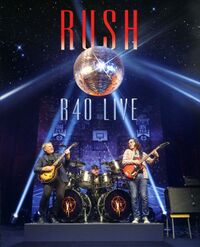
In 2015, Rush held the R40 Live Tour commemorating the 40th 41st anniversary of the band Neil Peart joining the band in 1974. After the tour's conclusion, Peart stated that Rush had largely retired from the music business, and may have quit making albums and touring for good.
After three years of leaving fans hanging on the edge, Lifeson bluntly said in 2018 that the band is done and has nothing to say anymore. Peart unfortunately passed away from brain cancer on January 7, 2020, in the first of many events that sent 2020 on its downward spiral. Currently, Rush are looking into merging with the Orkneyan heavy metal band Limbaugh and bringing back Peart as a hologram.
Little is known of what the distant future holds for Rush. One camp claims everything ("Geddy and Alex are going to go back on their word and reform Rush without Neil"), while another claims very little ("Geddy and Alex will occasionally perform together but not as Rush"), as Rush has done everything that they could possibly have done; their achievements rival those of Jack Bauer, Lennon/McCartney, and Oscar Wilde.
In 2022, Lifeson and Lee did a one-off reunion concert to promote the 25th anniversary of crude comedy series South Park, thankfully not under the Rush name since they didn't want to insult Neil's legacy. The two had already guested on the show numerous times and had music videos created for them in that paper cutout style. They were joined by series creators Trey Parker and Matt Stone, as well as fellow Canadian proggers Primus, to perform their old hit "Closer to the Heart". However, the performance didn't quite go as planned when they rushed the song for ten minutes.
Members[edit]
Geddy Lee[edit]
Geddy "Heady Geddy" Lee is a walking nose and glasses known for his voice capable of shattering paper and musical virtuosity on the bass. He is noted for being able to play insane licks on his bass by literally licking it, without even using his fingers. He has funny little glasses, a big nose, a goatee, and a headache that he oddly seems to enjoy. His large nose is actually fake (note his present face), and he has a lot of fake noses in his dressing room as seen in the Roll the Bones liner notes.
Alex Lifeson[edit]
Alex "Lifeless" Lifeson is regarded as a master guitarist/instrumentalist and a pioneer of electronic effects and chord structures, who records all his songs in the nude. He was voted guitarist of the year by Rolling Stone, but was stripped of his award when it was discovered he was growing madrigal inside his Gibson Limited Edition '12 Les Paul. His guitar solos often render listeners unable to control their arms.
Neil Peart[edit]
Neil "Real Pearty" Peart was a balding Drum Lord and occasional hat expert who played lots of drum solos, in which he hit numerous things in an angry fashion to achieve a very John Bonham-esque sound. Peart was not happy with just a basic drumkit so he found seven other kits and tied them together with the sap of 2,112 trees, forming a kind of shell of the drums; Neil felt very safe in his shell. His solos were also known to melt people's faces on a regular basis. Peart had a strange liking for triangles, and even named his first band "The Eternal Triangle" in secondary school. Neil Peart's Hat, a beanie, was considered a separate entity. It is said it host all of his powers, has stopped famine in Africa, prevented World War III, and invented sliced bread.
Musical style[edit]
“I once saw Rush live. They opened for Genesis. Also, I once ate a raw flower. Also, I once juggled 40 Slippermen at once.”
Rush is known for the insane instrumental virtuosity of its members, who often pull off their skillz one-handed and without wearing underwear, as well as their complex compost and electric lyrical bodies drawing heavily on Ayn Rand novels and high school bathroom scribblings. Rush has changed its musical underwear dramatically over the years, beginning in the vein of blues-blooded hard rock/heavy metal on their unanimous debut, then making the jump to styles encompassing progressive rock on the next five albums. From Permanent Waves on, they shifted to a more stripped-down pop rock style, then on Signals, moved into an '80s New Wave/synthpop style with guitar shoved into the background, to stay afloat in a period dominated by The Police and Phil Collins. On Presto, they ditched the synths and actually played guitar again, but had thin and brittle production until they regained that tougher alternative rock/grunge sound on Counterparts.
Acclaim and recognition[edit]
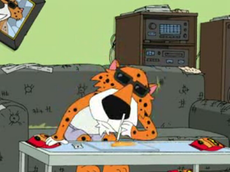
“Rush are quite good. You might say, they give me the Rushes...”
Rush's three-member lineup of Heady, Lifeless, and Pearty has dominated old folks' home grampcore talent competitions all over Canada and the Middle-earth music industry, and has earned the band many, many ice-cold beers and minor congratulations in the form of asexual favours from their fans. Indeed, Rush could be considered the greatest band ever, but they're Canadian so they automatically rock/suck depending on who you ask. Rush has influenced notable modern rock, metal, and prog artists such as Mentallica, The Smashing Mailboxes, Primutive, Cacophony X, and Nightmare Cinema.
Though not as popular as Dream Theater, Rush still maintains a minor cult following in the United States of America and the band's native Canada. Rush still holds the current RIAA record of "Most Dream Theater Fans in a Single Parking Lot Venue After Dream Theater Released a New Album"; the record set was 2.5. The previous record was only beaten after one fan lost the lower half of his body whilst attempting to squeeze between two large picture frames being moved from one end of the stage set to another in an attempt to beat the crowds to the local record store. The injured fan remained alive for two full hours and was thus counted as a part of the crowd for the record. In addition to Dream Theater, The Rolling Stones are also known to be a big enemy (within) of Rush, and despise the so-called "Rushians". While Rushians believe in being able to get whatever one desires, Stoners believe that you can't always get what you want, but you can usually get what you need — this is directly opposed to the oath that all Rushians must agree to when joining.
Rush has been awarded several pieces of bread lemony cake from the Juno Awards, and was inducted into the Canadian Music Hall of Fame in 1994. Over their careers, the individual members of Rush have surpassed their fellow talented studio musicians with each member being voted the most proficient players on their respective instruments in magazine readers' polls; this has often led to dangerous bar fights between rock fans over which poll candidate is better, culminating in several arrests and suicides by jumping off skyscrapers. As a whole, Rush boasts 21 gold and 12 platinum records, making them one of the best-selling rock bands in history; these statistics place them a long fucking way ahead of The Non-Denomonative Insects, The Moving Rocks, PASH, and Aeronautica for the most consecutive well-deserved media headjobs.
Why?:You should try Rush binge listening[edit]
“Don't get me wrong, but Rush? They're no April Wine...you know...I want to rock! R!”
Because Geddy, Neil, and Alex were one of the best trios in music — scratch that, the best trio in music. Have you ever heard the opening guitar riffs of the 2112 Overture? You have? Then that means you can agree it's among the best movements of progressive rock. Trust me. And if you don't, ask Jesse. He knows a lot about progressive rock.
I mean, remember on Family Guy when Chester Cheetah snorted a whole bunch of crushed Cheetos while listening to some Rush, got high on the cheese, and then broke his hand on the glass table? You remember what he said? Something along the lines of "NEIL PEART IS THE BEST FUCKING DRUMMER!" I wouldn't argue with Chester. In fact, if I ever got close to Neil, I'd probably faint and get a restraining order. But I'd probably ignore the restraining order on my wall and leg to go to Rush concerts. I think Rush. I dream Rush.
And when you listen to Rush in a chain, all your other problems vanish. You don't think about work, taxes, or the fact that there's a stranger eating Salisbury steak in your bathroom. Besides, what else are you going to listen to? The Decemberists? Not likely. Come on, you're better than that. Even people who like indie rock hate The Decemberists.
See also[edit]
- Genesis
- Yes
- King Crimson
- Led Zeppelin
- Metallica
- Trailer Park Boys
- Crash Test Dummies
- Primus
- Klaatu (band)
- Uriah Heep
- April Wine
- Kim Mitchell
| ||||||||||||||
| |||||||||||||||||||||||||
